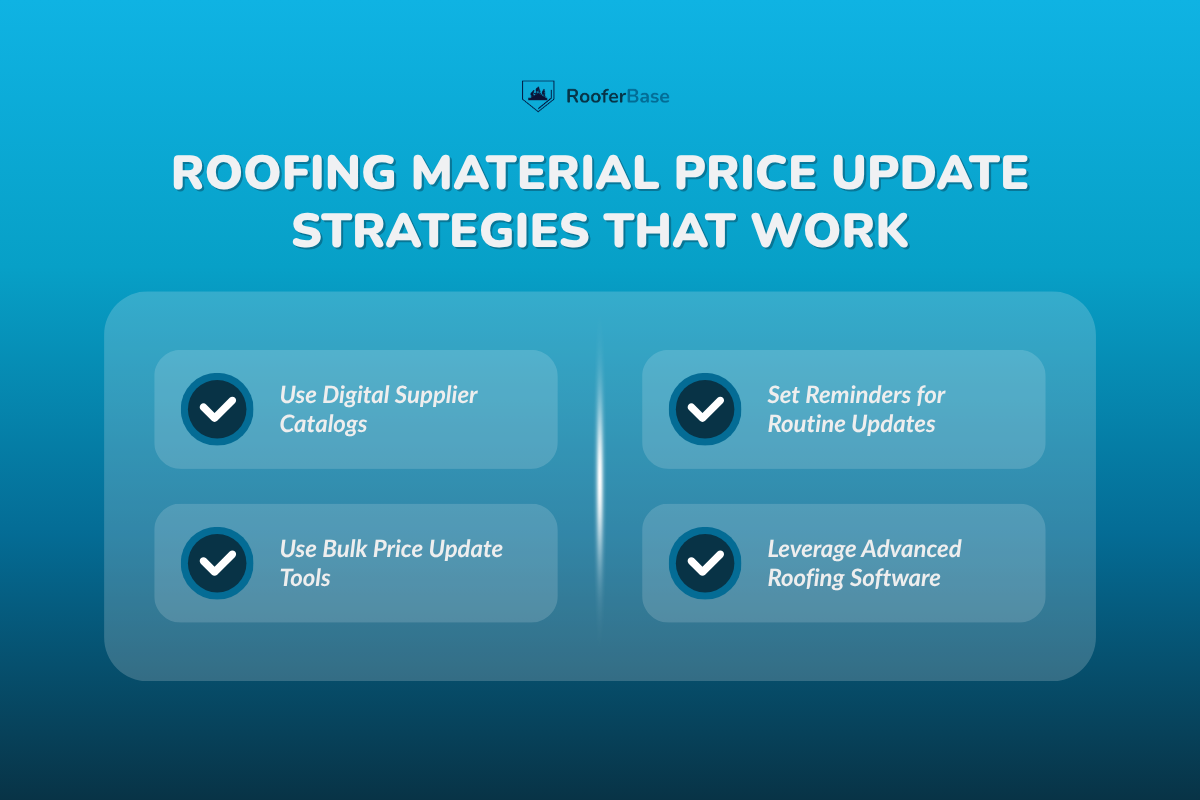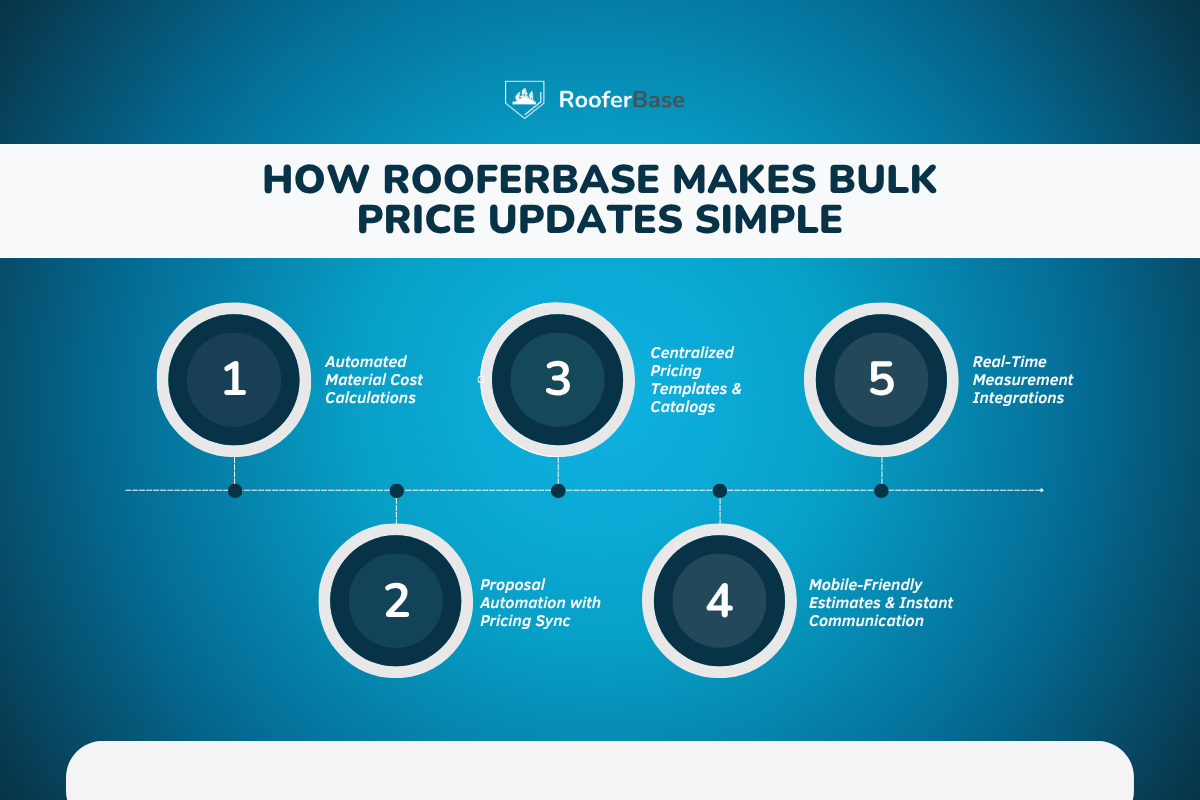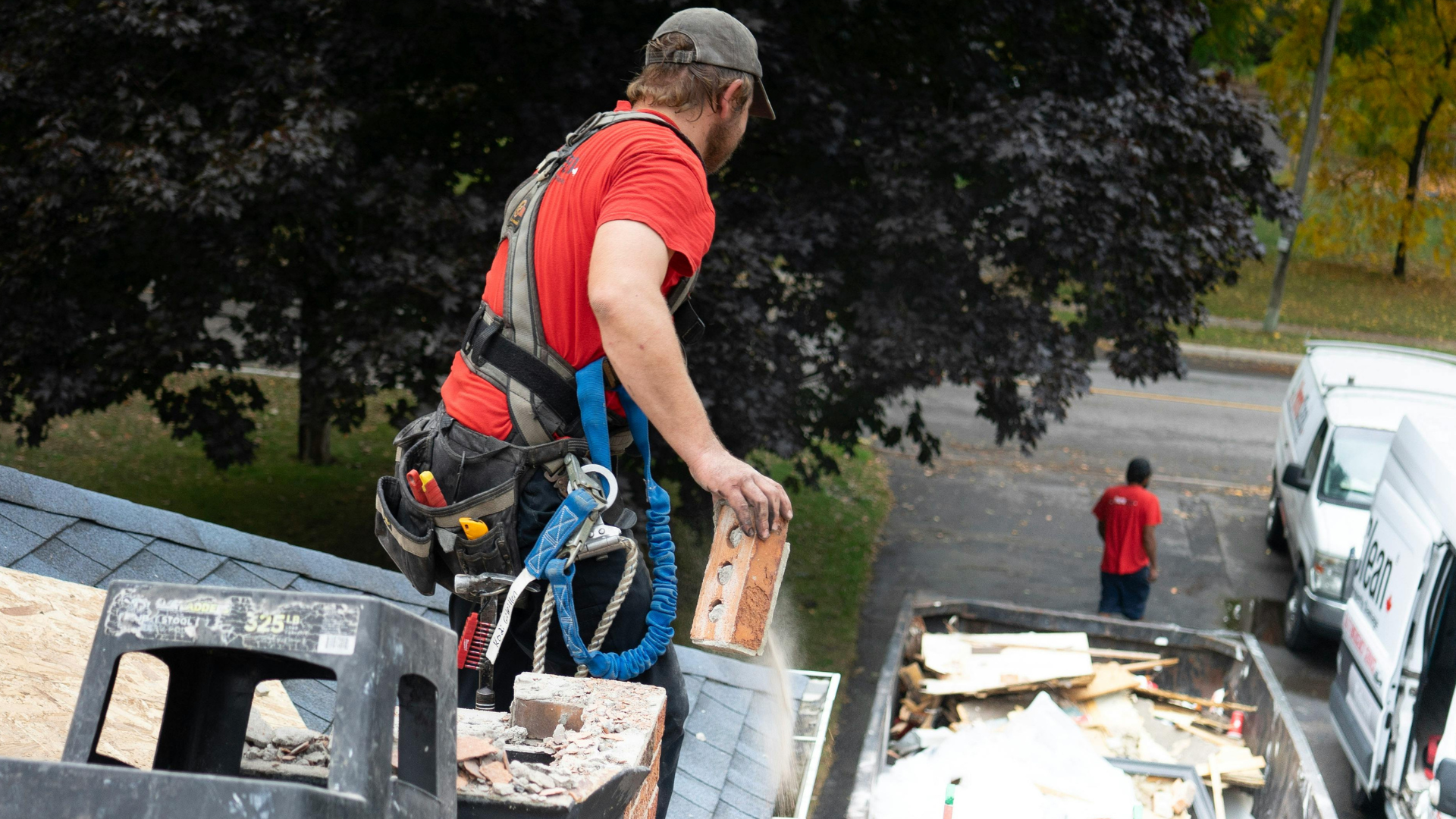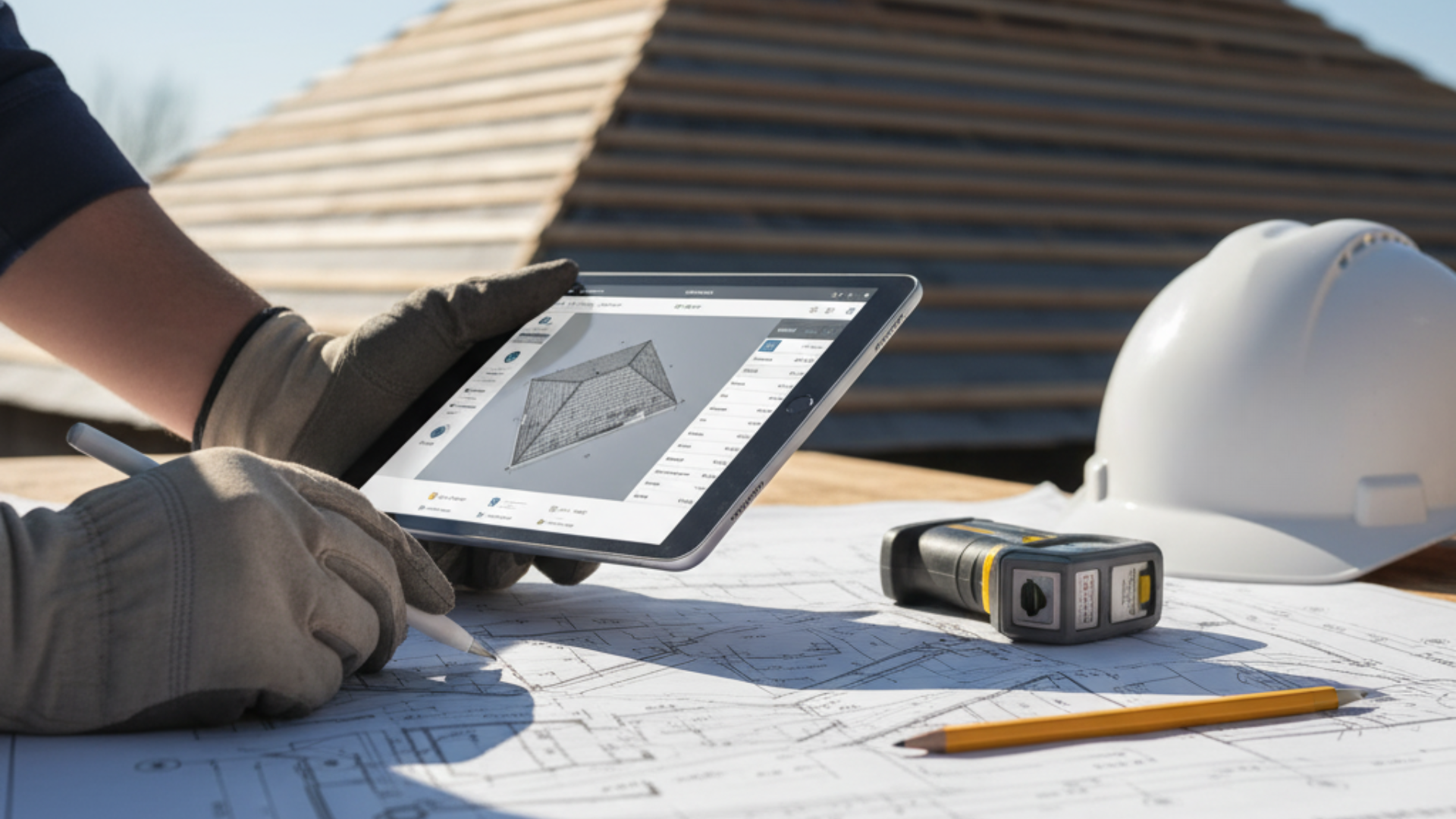October 7, 2025
If you’ve ever woken up at 3 AM wondering why your roofing estimates and replacement costs don’t add up anymore, you’re not alone here. Roofing material prices are climbing, dipping, and then climbing again; it feels like they’ve got a mind of their own.
From asphalt shingles to metal roofs, what you budget today might be outdated tomorrow. And if you’re still trying to chase these numbers down manually, you’re in for a long, exhausting ride.
Rising Costs? Here’s Your Roofing Material Price Update Guide for Faster Estimates
Think of roofing material prices like the weather: unpredictable and always changing. One day, asphalt shingles are steady, the next day they’ve spiked, and suddenly that “safe” estimate you gave to a client doesn’t look so safe anymore.
For roofing contractors, it’s not just about crunching numbers for labor, pitch, and square footage, or calculating costs per square foot anymore; the shifting cost of materials can tilt the whole project off balance.
That’s why staying on top of every roofing material price update isn’t just a nice-to-have; it’s the difference between keeping your margins healthy and watching them slip away.
In this guide, we’ll walk through what’s driving these price swings, how you can adjust your estimates without burning hours in spreadsheets, and the tools that make sure your bids stay competitive and profitable.
And with that, let’s unpack what’s happening, why it matters so much for your business, and, most importantly, how to get ahead with tools that actually do the heavy lifting for you.
Key Takeaways:
- Roofing material prices are volatile due to supply chain issues, fuel costs, and demand.
- Manual updates to estimates are slow, error-prone, and risky for profits.
- CRM and estimating tools with bulk update features save time and protect margins.
- RooferBase makes price updates simple by syncing new material costs across ongoing quotes.
- Transparent communication with clients is essential when passing along price changes.
The Challenge of Rising Roofing Material Costs
Roofing costs don’t just rise steadily like rent; they spike and dip more like gas prices on a long road trip. But why does this happen?
- Global supply chains: Asphalt shingles are tied to oil markets. Steel and aluminum for metal roofs often depend on overseas imports. Add in fluctuating fuel prices, and you’ve got a recipe for chaos.
- Weather and disasters: Every time a hurricane, wildfire, or storm tears through a region, thousands of homeowners suddenly need a roof replacement with new shingles. That demand sends prices soaring.
- Seasonal demand: Everyone wants roofing projects completed in spring and summer, which drives up material costs and overall average costs.
IBISWorld reports that roofing contractors faced supply chain constraints and high material costs alongside raised revenues.
The ripple effect is brutal: contractors underbid without realizing it, eat into their margins, and sometimes even lose money on a roofing job. On the other hand, customers become upset when their “roof replacement cost” unexpectedly balloons. For small roofing companies, it can feel like you’re working twice as hard but making half as much.
The Risk of Not Updating Your Estimates
Ignoring price updates is like ignoring a roof leak; it only gets worse.
- Underbidding: Your estimate looks good on paper, but by the time you buy materials, you’re bleeding profit.
- Overbidding: You scare clients off because you priced high out of fear. They go with a competitor who’s more up to date.
- Trust issues: Homeowners lose confidence when the final invoice doesn’t match the estimate. That’s how reputations take a hit.
Every missed update is a gamble with your business. And in roofing, gambles are expensive.
Why Manual Updates Don’t Work Anymore
Here’s the thing we miss out: many roofing contractors are still stuck in spreadsheet land. They copy-paste numbers, tweak line items one by one, and hope nothing changes in the meantime. But:
- That’s hours of work you could spend winning more jobs.
- One mistake in a cell formula, and your whole estimate is off.
- Clients feel misled when you “update” their quote two weeks later.
It’s like trying to replace shingles one at a time in the middle of a storm: slow, stressful, and NOT sustainable.
Want to know more? Take a look at this: Roofing Software vs. Manual Methods: Which Is Right for You?
Roofing Material Price Update Strategies That Work

Rising roofing material costs can feel unpredictable, but staying updated doesn’t have to be overwhelming.
With the right systems in place, you can manage fluctuations confidently, provide accurate estimates, and maintain profitability on every project by considering the key factors involved.
Below are four strategies most roofing contractors can implement right away:
1. Use Digital Supplier Catalogs
Relying on outdated PDFs or phone calls slows you down and increases the risk of errors.
Digital supplier catalogs give you real-time visibility into asphalt shingles cost, metal roofs, wood shingles, and other roofing materials. This ensures you’re always working with the most current data before submitting a free estimate.
For contractors juggling roof size, roof pitch, and labor costs, having live material updates means your pricing reflects market reality, not last month’s numbers.
2. Set Reminders for Routine Updates
Material costs don’t just change annually; they fluctuate monthly or even weekly. By setting regular reminders, you can monitor updates on standard asphalt shingle roofs, new shingles, or other materials without letting the task slip through the cracks.
A short, consistent review of material quality, average costs, and local building codes can prevent underbidding and reinforce your reputation as a roofing company that delivers both accuracy and cost effectiveness.
3. Use Bulk Price Update Tools
Manually adjusting line items across multiple estimates is inefficient and increases the risk of oversight. Bulk price update tools allow you to revise the asphalt shingles cost for a shingle roof, wood shingles, or other materials across your entire price book in one action.
When higher prices hit, these tools automatically update the overall cost, initial costs, and total cost for every estimate, saving time and ensuring no detail is missed. For contractors managing multiple roofing projects, this feature can protect margins and eliminate costly errors.
4. Leverage Advanced Roofing Software
Modern roofing software goes beyond spreadsheets. It centralizes all key variables, labor costs, roof pitch, shingle quality, material costs, and local building codes into one streamlined platform.
Key advantages include:
- Automatic price updates for materials like asphalt shingles, slate tiles, or composite shingles.
- Scenario comparisons to evaluate the cost-effectiveness of different options (e.g., metal roofs vs. asphalt shingles).
- Compliance integration with local building codes for proper installation.
- Professional client estimates that highlight benefits such as energy efficiency, low maintenance, and the roof's lifespan.
- By reducing guesswork and ensuring accuracy, advanced tools allow roofing contractors to plan ahead, minimize risk, and deliver consistent value to clients, including benefits like energy efficiency.
These strategies are not just about keeping up with rising costs; they’re about building resilience into your roofing services.
By combining technology with routine practices, you can stay competitive, provide reliable estimates, and protect profitability despite ongoing price increases.
Take a look at: The Future of Roofing Estimation: Trends & Innovations for 2025
How CRM Tools and Estimating Software Solve This Problem
When it comes to roof replacement projects, even a small pricing error can cost roofing contractors tens of thousands of dollars over the year.
The problem? Roofing materials like shingles, cedar shakes, or flat roofs change prices quickly, especially during a full roof replacement, and old spreadsheets or outdated catalogs can’t keep up.
A CRM or estimating platform built for roofers eliminates this risk by giving you the tools to keep every quote accurate, consistent, and cost-effective.
1. Bulk Price Updates from a Central Database
- Instead of reworking estimates every time old shingles or decking costs change, you get custom pricing catalogs, a centralized system where material and labor costs are updated once.
- Every estimate, template, and proposal tied to that catalog updates instantly, whether it’s for shingle material, cedar shakes, or flat roofing systems.
- This not only protects profit margins but also ensures homeowners see transparent, up-to-date numbers.
2. Automated Material Cost Calculators
- With automated calculators, the system recalculates project costs in real time.
- If Owens Corning shingles rise in price or flat roof membranes drop in price, active quotes adjust instantly.
- This means you’re never stuck underquoting a new roof or overcharging for roofing materials; your bids stay fair, competitive, and profitable.
3. Batch Edit/Update Functions
Need to adjust prices across hundreds of jobs?
- Batch editing tools let you push changes to categories like all shingle material or underlayment at once.
- For contractors working by the square foot, this ensures that even large-scale projects are always priced accurately without hours of manual updates.
4. Supplier Database Integration
- By connecting directly to supplier feeds, your pricing catalog syncs with current roof material costs.
- No more waiting for calls or emails about increases; your estimates always reflect today’s market.
- This is especially critical for projects requiring materials that resist fire, last longer with minimal maintenance, including drip edge, or appeal to cost-conscious homeowners looking for a new roof.
5. Template-Driven Estimate Generation
- Since proposals are built on master templates tied to the catalog, every roof replacement estimate, whether for asphalt shingles, cedar shakes, or flat roofs, automatically reflects updated prices.
- Contractors save time, avoid duplicate work, and deliver quotes that clients can trust.
Let's take a scenario Example:
- A Florida roofing contractor lost nearly $8,000 last year after failing to update the price of old shingles in their manual estimates.
- Another contractor, using catalog-based bulk updates, saved $5,000 in a single quarter because their CRM recalculated every ongoing estimate instantly.
For them, what once felt like a headache turned into a streamlined process that boosted trust, reduced errors, and kept margins healthy.
The result? Faster, more accurate quotes, consistent pricing for every square foot of roofing material, and the confidence that every roof replacement project, from fire-resistant shingles to minimal-maintenance flat roofs, is cost-effective for both contractors and homeowners.
Step-by-Step Guide to Updating Estimates Fast
Updating estimates doesn’t have to be complicated. Here’s a simple 5-step plan:
Step 1: Audit Your Current Estimate Templates
Check for outdated costs on roof decking, drip edge, and shingles. You’d be surprised how old some numbers are.
Step 2: Configure Central Material Pricing in Software
Build your “master price list” so you’re never hunting through emails again. Include suppliers, lead times, and seasonal price variations.
Step 3: Run Bulk Price Updates Weekly or Monthly
Make it a habit. Prices change; your system should too. Automate updates wherever possible to reduce manual errors.
Step 4: Communicate Revisions Clearly to Clients
Don’t just send a new number, show them what changed. Side-by-side comparisons, notes on updated materials, or new timelines build trust and reduce disputes.
Step 5: Monitor Margins and Track Performance
Keep an eye on whether you’re absorbing increases or passing them on. Data keeps your business healthy. Track actual costs versus estimates to refine your pricing strategy over time.
Communicating Price Changes to Clients Without Losing Trust
Now here’s the truth: homeowners will understand rising roof costs if you handle it the right way. It’s like telling them about a roof repair; you win trust by explaining, not hiding.
- Be upfront: Tell them raw material prices have gone up. They’ve seen the news.
- Offer alternatives: Swap premium slate tiles for composite shingles if the budget is tight.
- Version your quotes: Let them see how the numbers changed. It makes you look transparent, not shady.
Pro tip: Empathy sells. If you show your care about keeping their costs under control, they’ll stick with you.
How RooferBase Makes Bulk Price Updates Simple

RooferBase provides the exact tools contractors need to keep their roofing material prices accurate and up to date, without hours of manual rework. Here’s how:
1. Automated Material Cost Calculations
- RooferBase uses dynamic pricing adjustments that auto-refresh estimates in real time.
- If the cost of shingles, cedar shakes, or flat roof membranes changes overnight, your quotes instantly reflect the new rates.
- No more digging through spreadsheets or chasing down old proposals.
2. Centralized Pricing Templates & Catalogs
- With pre-built pricing templates and catalogs, you can update material and labor costs once, and the changes ripple across every proposal and job file.
- Whether you’re pricing a roof replacement by the square foot or adjusting for fire-resistant shingles, consistency stays locked in.
3. Real-Time Measurement Integrations
- RooferBase also integrates with aerial imagery and satellite tools, so your estimates aren’t just priced correctly, they’re measured correctly, too.
- This reduces waste, ensures precise material ordering, and indirectly supports price accuracy by avoiding over- or underestimating roof size.
4. Proposal Automation with Pricing Sync
- Quotes don’t sit outdated in a client’s inbox. RooferBase pushes pricing updates instantly to proposals, so your customers always see the most current numbers.
- That means fewer awkward conversations about “unexpected increases” and more confidence in your professionalism.
5. Mobile-Friendly Estimates & Instant Communication
In the field? No problem.
- RooferBase allows mobile-friendly estimates, so contractors, project managers, and sales reps stay aligned on every pricing change.
- Everyone from the office to the jobsite has the same numbers at the same time.
What Contractors Often Overlook (But RooferBase Doesn’t)
Many roofing contractors think price accuracy is only about materials. In reality, they often overlook:
- Waste factors that inflate costs when not recalculated.
- Labor rate shifts that can add up to thousands over multiple jobs.
- Old shingles disposal fees sneak into budgets.
- Markup consistency, where small errors across jobs add up over time.
RooferBase keeps these details in check. By automating the small things that are easy to overlook, it ensures every estimate, whether for minimal-maintenance flat roofs or premium cedar shakes, is truly accurate, competitive, and cost-effective.
About RooferBase
At RooferBase, we get it. Keeping up with roofing material price updates feels like chasing your own tail. That’s why our roofing estimate software is built for real contractors, not spreadsheets.
From asphalt shingle roof replacements to steep roof repairs with premium materials, we help you plan ahead and protect your profits.
Ready to stop guessing and start winning? Get your inspection and demo today.
FAQs
Q1. Why are roofing material prices rising so often?
Supply chain issues, rising fuel costs, and seasonal demand are the main culprits.
Q2. How often should contractors update their material prices?
At least monthly. Weekly, if you’re doing a lot of full roof replacements or using premium shingles.
Q3. What’s the risk of not updating estimates quickly?
Lost profits, lost clients, and lost trust.
Q4. Can software really update all my quotes at once?
Yes. That’s exactly what bulk price updates are for.
Q5. Do clients usually accept revised quotes?
Most do, especially when you explain rising material costs and show them the data.






